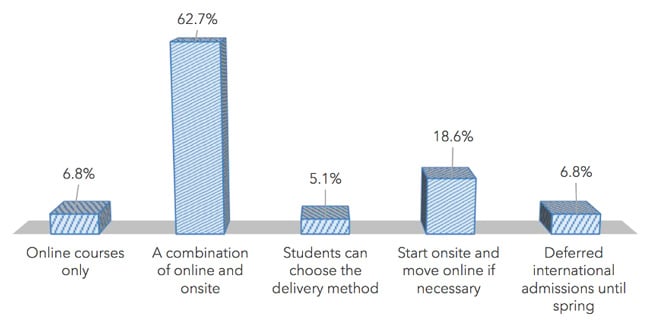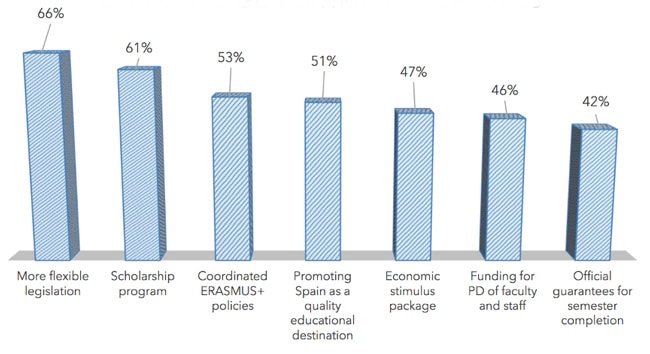Spanish universities detail pandemic impacts and strategies for 2020/21
- Spain enrolled more than a million international students before the pandemic, and its universities expect to lose more than half of their international enrolments this academic year compared to the previous one due to the effects of COVID-19
- In the fall of 2020, a hybrid model combining on-site with online learning was the dominant mode of delivery for domestic and international students alike
Spain is a major study abroad destination – enrolling nearly 1.1 million international students across all education sectors in 2018/19. Its universities, like those in so many countries, are now reporting significant impacts as the pandemic continues to curb international travel.
A survey conducted in the fall of 2020 by Spain Education Programs (SEP) of 101 Spanish higher education institutions asked respondents to predict how much international enrolments might fall in the current academic year and to say what kind of educational experience they are offering to international students in this challenging time.
International enrolments could fall by more than half
The survey found that on average, responding universities expected to lose more than half (57%) of their international students in the current academic year compared with 2019/20.
Such a loss will be deeply felt across the economy – and the extent of the loss to some degree depends on how much Spanish universities deliver at least some part of their courses on-site as opposed to online. This is because, as in all destination countries, international students’ overall spending on their education experience is much higher than what they spend on tuition.
A report by Spain Education Programs (SEP) with support from ICEX (a public arm of Spain’s Ministry of Industry, Trade and Tourism) and the association EDUESPAÑA found that,
“[International students’] overall economic impact on the Spanish economy amounts to 3,795,740,732 euros and that the multiplier effect for student spend is 2.27. A multiplier effect of 2.27 indicates that for each euro spent on their academic programme, these international students spent an additional 1.27 euros on a broad range of sectors of the Spanish economy.”
The report also notes that,
“… a 2.27 multiplier indicates a high level of dependence on students attending on-site programmes. In all categories, except for master’s degrees, participants spend more on the extra academic aspects of their experience than on their tuition.”
For the moment, most Spanish universities are trying to retain at least some portion of their on-site delivery model. The fall 2020 SEP survey found that the dominant model of education delivery to both domestic and international students at that time was a hybrid model comprising both on-site and online instruction.
Hybrid models are the norm
Roughly 8 in 10 Spanish universities were offering a combination of online and offline instruction in the fall, with some of these (19%) opting to starting courses in-person and then switch to online if necessary. Only 7% had moved all courses for international students online.

At the time of the survey, most universities (67%) were committed to creating online communities to foster intercultural connections, but the largest proportion of those institutions (41%) had not yet launched such a feature compared to 19% that already had an online community and 7% that had recently created one.
A third of the surveyed universities said that they intended to promote intercultural interaction in other ways, including on-site activities and “international online events and seminars with our European partners, existing student associations, buddy programs, Facebook groups, and language and cultural exchange programmes with locals.”
What would encourage more international students to study in Spain this year?
Asked what kind of measures the Spanish government could enact to encourage international enrolments, the largest proportion of respondents (66%) wanted “more flexibility in legal requirements and processes, including access to undergraduate degrees, obtaining student visas, and opening bank accounts.” Scholarship programmes were also high on the list, with 61% of respondents citing this as a good priority for the government.

Most international students live off-campus
The report conclusion offers some insights into the rationale for Spanish universities retaining some element of on-site instruction in their instructional model despite the spread of COVID-19. The authors note that unlike colleges in the US,
“Spanish universities do not have residential campuses as those of institutions stateside. Most of the students are commuters still living at home, while internationals typically also live off-campus. That, along with strict regulations for participation and enforcing health measures for on-site components, should diminish contagion risks.”
At the time of writing, the SEP report authors were able to compare Spanish universities’ tendency to keep a component of in-person instruction in their approach with the approach used in the UK. They noted (citing a Universities UK poll):
“In the UK, “97% of the universities surveyed said they will provide some in-person teaching to students at the start of term this year, whilst 87% are planning to provide in-person sporting, fitness and wellbeing activities.”
Since then, however, the COVID situation in the UK has become worse, and in-person classes have been suspended until at least mid-February.
Spain has been in a state of emergency since November 2020 due to rising COVID infections.
For additional background, please see:
















